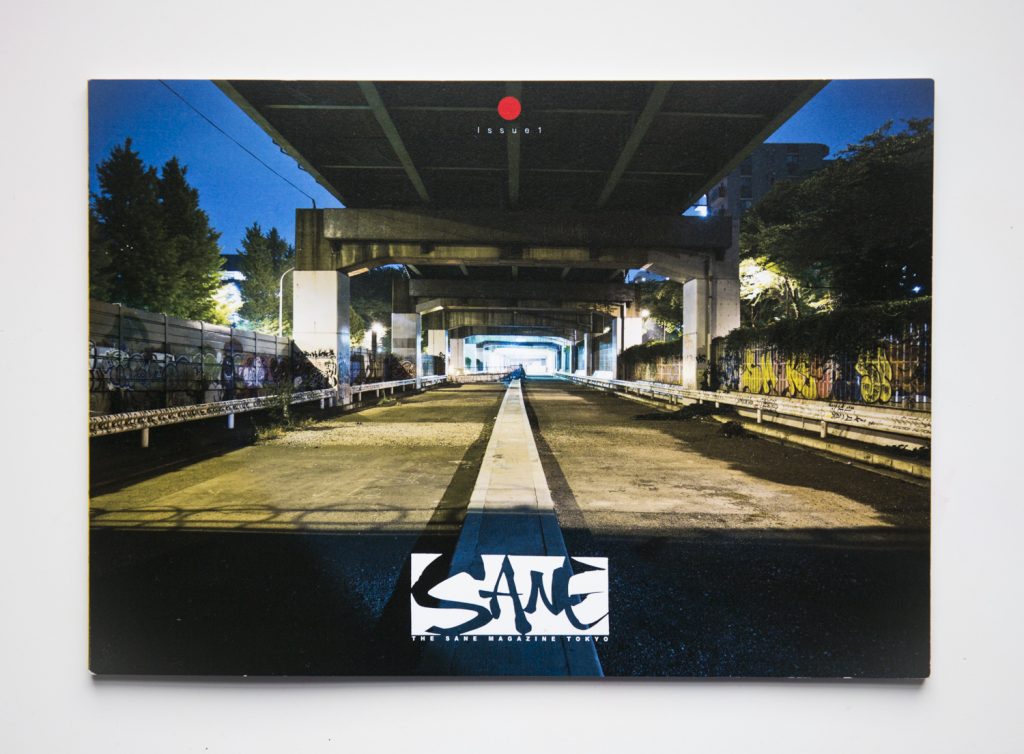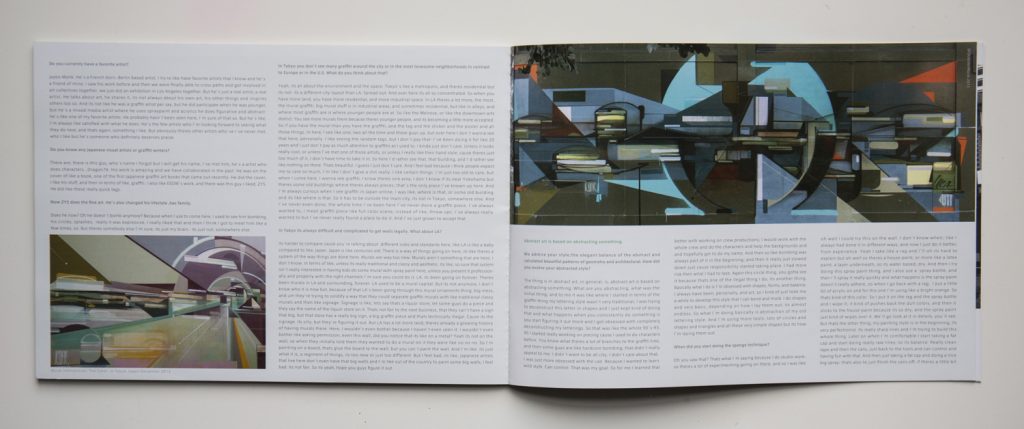On a recent trip to Japan a friend brought back a copy of Sane magazine. Based in Tokyo it’s apparently one of only three graff mags from the country. It begins with an introduction explaining the effects graffiti can have on an individual level which boils down to a hard lesson in the value of “effort and persistence. It nurtures the ability to see the core of things and the ways of society which we are not taught at school.” However the aim of Sane isn’t to delve into “the possibility of graffiti itself or its essentiality” but, on a more aesthetic level, to display great works of art. In fact the increasing popularity of large scale murals is described as a ‘new dawn’ awaiting graffiti.
The magazine is laid out into sections showing the work of six individuals. Three of these feature interviews with artists from Europe. The first of them is Nychos who paints huge anatomical studies of cartoon-like animals across buildings. Originally starting out with graffiti letters he describes what has affected the evolution of his work. Quite often it’s a bit difficult to see the influences people attribute to their art. However Nychos says that both a childhood love of comics and growing up in a rural hunting community find expression in his murals. Looking at the pictures it’s quite obvious where he’s coming from. The following interview with Demsky reveals a love of 80’s computer games that’s translated into science-fiction style productions. The result is some incredible and original pieces. Unlike Nychos his walls are letter based but still push at the boundaries of convention. The third European writer Sawe has the most recognisably ‘graff’ style which is mixed with his work as an illustrator. He describes how graffiti has changed the way he experiences his environment compelling him to notice “all the corners of blind shutters, roads, highways, and trains in a schizophrenic way.” Ultimately what keeps Sawe going is the simple fact that it is “really fun!”
Later in the magazine are a couple more interviews which include discussion relating to Japan. Kofie is a muralist from LA who has also painted in Japan. His abstract walls all come from obsessively deconstructing letter forms down into crisp clear shapes. The paintings seem to revolve around a central circular point interrupted by sharp blocks of blank colour. Aside from describing his works Kofie also talks about his experiences of Japan. He obviously finds the place fascinating and points out how the mundane details of a foreign city can be so interesting to a visitor. In comparison to his hometown of LA Kofie thinks the compact residential layout of Tokyo hinders graffiti. The two places also have very different cultures, so while LA is a modern city with a tradition of murals, Tokyo is a much older place with a more rigid view of how public space is used. The only Japanese artist interviewed in Sane also discusses the restrictions of wall writing in Japan. Imaone says that, as there’s not much opportunity to practice his art on public walls, he relies on his life experiences and imagination when creating his murals of graffiti style characters. He compares the process of painting a building to making ramen; “You prepare the soup, boil the noodles, and serve it to the customer.”
He compares the process of painting a building to making ramen; “You prepare the soup, boil the noodles, and serve it to the customer.”
Apart from the interview sections there are also a few other bits-and-bobs in Sane. One of these is a nice photographic feature on QP who paints big black and white numbers with a mixture of latin or Japanese script. One of his photos of a ‘H S’ painted high up on a rooftop, contrasting with the Japanese typography surrounding it, really stood out in the magazine. Meanwhile in the centre of the mag there is a spread of postage stamp sized flicks of street bombing from around the world – which feels a bit out of place with the rest of the content. Finally the mag ends with an essay titled ‘from Struggle For Pride’. Again this is a slightly odd part of the publication which doesn’t really seem to connect to anything else in it. It’s a bit difficult to describe the gist of the text other than it’s about someone meeting up with other people to discuss their band. I guess something was lost in translation here.
After reading Sane I haven’t really got a much better feel for the streets of Tokyo or Japan which is what I was looking for. However the magazine has interesting interviews, quality pictures, and is well put together. Perhaps because of the climate in Japan Sane promotes the work of international muralists whose featured art is both impressive and accomplished. While they cooperate with property owners and residents or aim to challenge the viewer ultimately, as Nychos puts it, “we do art for ourselves.” This is one way in which these mega-scale works depart from street graffiti. Taken out of a gallery context monumental murals bring art directly to the lives of the public. However unlike street graffiti, which I think encourages public participation (whether good or bad), this is all about public observation. These aren’t community murals created around local issues or struggles but very much focused on the artist. I was recently flicking through a book by the historian John Dower, who has emphasised the importance of ‘visualising cultures‘. In Japan in War and Peace he lists graffiti recorded during WWII by the Japanese police: “Attack the government’s running-dog police…. Anarchism. Anarchism. Stand up, proletariat. Destroy the bourgeoisie.” Which I think is a nice note to end on here.


